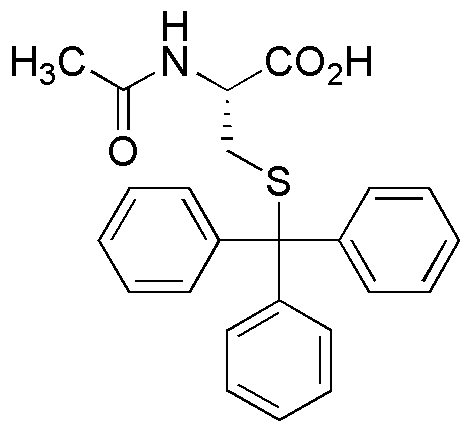Acetyl-S-trityl-L-cysteine is widely utilized in research focused on:
- Drug Development: This compound serves as a key intermediate in synthesizing pharmaceuticals, particularly in developing treatments for conditions related to oxidative stress and inflammation.
- Biochemical Research: It is used in studies examining protein folding and stability, helping researchers understand diseases linked to misfolded proteins.
- Antioxidant Applications: The compound acts as a potent antioxidant, making it valuable in formulating supplements aimed at reducing oxidative damage in cells.
- Cosmetic Industry: Its properties are leveraged in skincare products to enhance skin health by providing protection against environmental stressors.
- Analytical Chemistry: Acetyl-S-trityl-L-cysteine is employed in various analytical techniques to detect and quantify thiol compounds, aiding in quality control processes in laboratories.
General Information
Properties
Safety and Regulations
Applications
Acetyl-S-trityl-L-cysteine is widely utilized in research focused on:
- Drug Development: This compound serves as a key intermediate in synthesizing pharmaceuticals, particularly in developing treatments for conditions related to oxidative stress and inflammation.
- Biochemical Research: It is used in studies examining protein folding and stability, helping researchers understand diseases linked to misfolded proteins.
- Antioxidant Applications: The compound acts as a potent antioxidant, making it valuable in formulating supplements aimed at reducing oxidative damage in cells.
- Cosmetic Industry: Its properties are leveraged in skincare products to enhance skin health by providing protection against environmental stressors.
- Analytical Chemistry: Acetyl-S-trityl-L-cysteine is employed in various analytical techniques to detect and quantify thiol compounds, aiding in quality control processes in laboratories.
Documents
Safety Data Sheets (SDS)
The SDS provides comprehensive safety information on handling, storage, and disposal of the product.
Product Specification (PS)
The PS provides a comprehensive breakdown of the product’s properties, including chemical composition, physical state, purity, and storage requirements. It also details acceptable quality ranges and the product's intended applications.
Certificates of Analysis (COA)
Search for Certificates of Analysis (COA) by entering the products Lot Number. Lot and Batch Numbers can be found on a product’s label following the words ‘Lot’ or ‘Batch’.
*Catalog Number
*Lot Number
Certificates Of Origin (COO)
This COO confirms the country where the product was manufactured, and also details the materials and components used in it and whether it is derived from natural, synthetic, or other specific sources. This certificate may be required for customs, trade, and regulatory compliance.
*Catalog Number
*Lot Number
Safety Data Sheets (SDS)
The SDS provides comprehensive safety information on handling, storage, and disposal of the product.
DownloadProduct Specification (PS)
The PS provides a comprehensive breakdown of the product’s properties, including chemical composition, physical state, purity, and storage requirements. It also details acceptable quality ranges and the product's intended applications.
DownloadCertificates of Analysis (COA)
Search for Certificates of Analysis (COA) by entering the products Lot Number. Lot and Batch Numbers can be found on a product’s label following the words ‘Lot’ or ‘Batch’.
*Catalog Number
*Lot Number
Certificates Of Origin (COO)
This COO confirms the country where the product was manufactured, and also details the materials and components used in it and whether it is derived from natural, synthetic, or other specific sources. This certificate may be required for customs, trade, and regulatory compliance.


